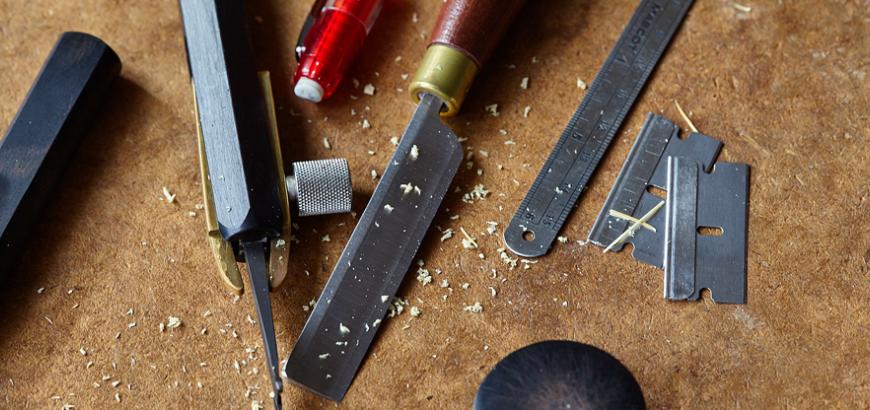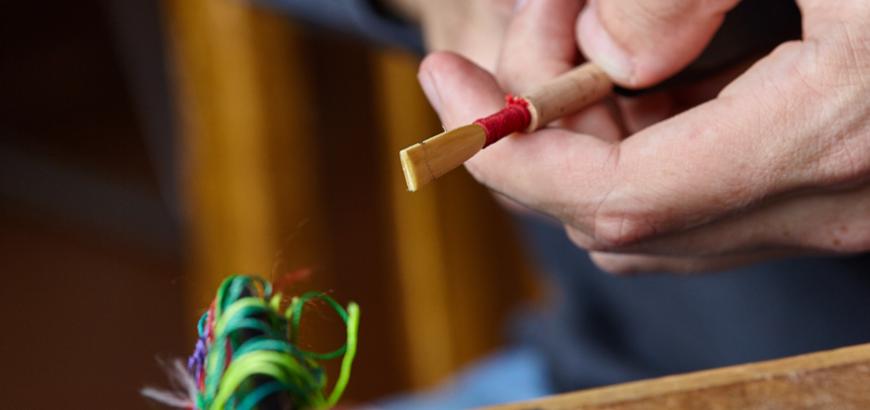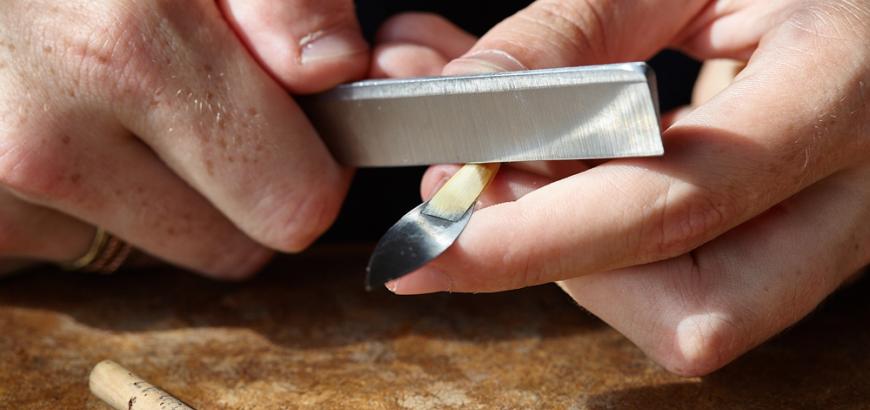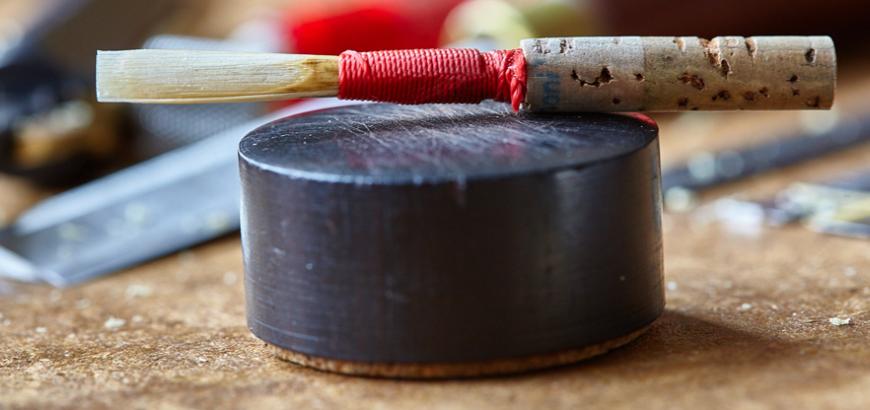When UW music student Logan Esterling decided, in his sophomore year of high school, to switch from saxophone to oboe in order to fulfill his dream of performing in an orchestra, he had no idea that he was consigning himself to a life requiring constant, diligent attention to his instrument far above and beyond that required of other instruments in the ensemble.
He had no idea he would soon be carrying four knives in his oboe case wherever he’d go and that razor blades and sandpaper would figure prominently in his daily routine. Becoming an oboist meant he would become one of the hardest working musicians in the orchestra, and not because of the hours of practice required to master the instrument, though the practice required is no small thing to contemplate.
No, the defining difference, the thing that sets players of oboes and bassoons and clarinets apart from the rest, are the reeds themselves. Inside a small case Esterling carries with his instrument is a set of reeds, made of cane grown in the south of France, and meticulously fine-tuned to achieve optimum sound attributes. As Esterling has discovered, he has had to commit to becoming a skilled reedmaker in addition to a skilled musician to be the best oboist he can be. That means in addition to learning to play, he has had to learn to scrape, to shape, to soak, to fold, to gouge, and then to scrape some more, all in exact measure and with varying results.
At the School of Music, reedmaking is taught by two expert practitioners—bassoonist Seth Krimsky and oboist Mary Lynch, who both serve as principals of their respective instruments with Seattle Symphony in addition to their work on the School of Music faculty.
It takes a certain focus to excel at the mastery of the craft as well as patience and a willingness to make a lot of inferior reeds in the process of learning. Lynch cites a quote from John Mack, longtime principal oboist of the Cleveland Orchestra, who famously said, “You have to make an entire laundry basket of reeds before you can start to become adept.”
Esterling, a sophomore who performs in both the UW Symphony Orchestra and the Wind Ensemble, is on his way to becoming adept. He spends an average of two hours per day on reedmaking on top of his class and rehearsal schedule.
“You can do it in a day if you’re lucky,” he says when asked how long it takes to make a reed, “but normally it takes three or four days. In three or four days I have a reed that might be decent, and then I’ll take it to my teacher, and she will make it beautiful.” A reed Esterling might use in a concert performance could take as long as a week or two of scraping and adjusting before reaching the desired state. All this for a reed that may be used in practice and performance for perhaps two weeks before it no longer produces an adequate tone.
The qualities that make a good reed, according to Lynch, are “response, pitch, and tone quality.” When working to make her reeds work best for her, she’s looking for a reed that feels cohesive and balanced, keeping those three priorities in mind.
“When a reed sounds good to me, it’s usually because it’s up to pitch, it’s easy and it’s free blowing, and it’s balanced so that it vibrates in a way that allows me to produce a beautiful, round, varied and layered kind of tone color," she says.
How many reeds does a double-reed player require for a typical performance?
“It only takes one,” Lynch says. “If I have one that I feel really confident on, I feel great. Good to go. Plus two or three that are adequate. That one golden reed comes along maybe once a season, but in my usual orchestral routine, I’ll make five reeds a week and assuming all of my equipment—my gouging machine, the cane I have ordered— is good then four out of five of those reeds I’ll be able to play on in orchestra. If something is malfunctioning with a piece of reedmaking equipment I have, then that is when things can get really tough and really trying."
Even so, Lynch embraced the challenge of reedmaking from the start. “I always liked whittling as a kid; I was a Girl Scout, and I liked to whittle, so I just thought, 'Oh, it’s like sophisticated whittling.'" She laughs. "It’s extremely sophisticated whittling. I was excited to learn, and I had no idea what I was getting myself into.”
Neither did Esterling, but the revelations have been rewarding. For one thing, he says, he's realized the value of single-minded concentration to his work, and how actions have consequences in reedmaking as in life. Though he sometimes tries to multi-task, working on reeds while watching Netflix or listening to good music, he finds reedmaking far from a mindless activity; it requires attention to detail and intense concentration.
"I'm really trying to start focusing on what I'm doing when I make a reed," he says. "and how every tiny little touch of the knife affects your sound."
Double Reeds: Step by Step
By Logan Esterling
Special to Whole Notes
A hair of a cat, the shavings from an eraser, a petal from a flower, and the skin of an apple. All of these random ingredients are around the same thickness as the two blades of a finished oboe reed. Take a look at the thickness of a fingernail; reedmakers are shaving cane to be even thinner than that.
As with every aspect of making a reed, the “ideal measurements” are unique to each oboist’s style of playing. Regardless of personal ideals, attention to detail is a trait that reed-ers are required to have.
Every reed begins with cane. The cane used in modern reed making is of the variety Arundo Donax. This type of giant 20-foot cane is grown across the globe, but most oboists revere the cane from the southern Var area of France. In assessing the quality of a piece of cane, the oboist prioritizes straightness and a consistent diameter between 10 and 10.5 millimeters. The section with ideal measurements is sliced off of the tube cane. Each piece is then cut to the proper length and the middle of the cane is shaved using a gouging machine.
After ensuring the cane is properly soaked, the reedmaker folds it in half. The folded piece of cane fits onto a shaper tip where the excess cane is shaved off using razor blades.
At this point the cane is ready to be tied and scraped. The cane is fastened onto staples, which are typically brass or silver tubes that have cork on the bottom half to enable easy attachment into the top of the oboe. The standard length of a staple is 47 millimeters long, but that is also subject to preference.
The reed is tediously tied to be sure that the sides are not leaking and that the thread does not go past the end of the staple. The segments of the reed are then outlined in pencil and the reedmaker begins scraping. First they outline the tip of the reed, which is roughly four millimeters from the top, and then they scrape out the middle, or heart, of the reed. Once these two sections are distinguished, the end of the reed is clipped open using a razor blade. There is now an opening at the top, where a plaque (small scraping board) is inserted. This allows for scraping on the tip and heart of the reed. The back channels of the reed, which run along the left and right sides, are scraped after the heart and tip are closer to being finished.
Scraping allows for the most customization per individual player. While this is the process for starting a reed, the making of a reed never really ends. The reed continues to be scraped on until it eventually stops working, cracks, or gets sliced by the knife.







